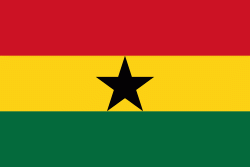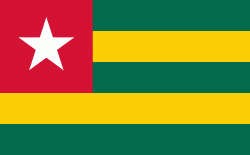Ewe language
Ewe (Eʋe or Eʋegbe ) is a language spoken by approximately 20 million people in West Africa, mainly in Ghana, Togo and Benin, and also in some other countries like Liberia and southwestern Nigeria. Ewe is part of a cluster of related languages commonly called the Gbe languages. The other major Gbe language is Fon, which is mainly spoken in Benin. Like many African languages, Ewe is tonal as well as a possible member of the Niger-Congo family.
The German Africanist Diedrich Hermann Westermann published many dictionaries and grammars of Ewe and several other Gbe languages. Other linguists who have worked on Ewe and closely related languages include Gilbert Ansre (tone, syntax), Herbert Stahlke (morphology, tone), Nick Clements (tone, syntax), Roberto Pazzi (anthropology, lexicography), Felix K. Ameka (semantics, cognitive linguistics), Alan Stewart Duthie (semantics, phonetics), Hounkpati B. Capo (phonology, phonetics), Enoch Aboh (syntax), and Chris Collins (syntax).
Some of the commonly named Ewe ('Vhe') dialects are Aŋlɔ, Tɔŋu (Tɔŋgu), Avenor, Agave people, Evedome, Awlan, Gbín, Pekí, Kpándo, Vhlin, Hó, Avɛ́no, Vo, Kpelen, Vɛ́, Danyi, Agu, Fodome, Wancé, Wací, Adángbe (Capo).
Ethnologue 16 considers Waci and Kpesi (Kpessi) to be distinct enough to be considered separate languages. They form a dialect continuum with Ewe and Gen (Mina), which share a mutual intelligibility level of 85%; the Ewe varieties Gbin, Ho, Kpelen, Kpesi, and Vhlin might be considered a third cluster of Western Gbe dialects between Ewe and Gen, but Kpesi is as close or closer to the Waci and Vo dialects, which remain in Ewe in that scenario. Waci intervenes geographically between Ewe proper and Gen; Kpesi forms a Gbe island in the Kabye area.
Ewe is itself a dialect cluster of the Gbe languages, which include Gen, Aja, and Xwla and are spoken from the southern part of Ghana to Togo, Benin and Western Nigeria. All Gbe languages share at least some intelligibility with one another. Some coastal and southern dialects of Ewe include Aŋlɔ, Tongu (Tɔŋu), Avenor, Dzodze, and Watsyi. Some inland dialects indigenously characterized as Ewedomegbe include: Ho, Kpedze, Hohoe, Peki, Kpando, Aveme, Liati, Fódome, Danyi, and Kpele. Though there are many classifications, distinct variations exist between towns that are just miles away from one another.
The German Africanist Diedrich Hermann Westermann published many dictionaries and grammars of Ewe and several other Gbe languages. Other linguists who have worked on Ewe and closely related languages include Gilbert Ansre (tone, syntax), Herbert Stahlke (morphology, tone), Nick Clements (tone, syntax), Roberto Pazzi (anthropology, lexicography), Felix K. Ameka (semantics, cognitive linguistics), Alan Stewart Duthie (semantics, phonetics), Hounkpati B. Capo (phonology, phonetics), Enoch Aboh (syntax), and Chris Collins (syntax).
Some of the commonly named Ewe ('Vhe') dialects are Aŋlɔ, Tɔŋu (Tɔŋgu), Avenor, Agave people, Evedome, Awlan, Gbín, Pekí, Kpándo, Vhlin, Hó, Avɛ́no, Vo, Kpelen, Vɛ́, Danyi, Agu, Fodome, Wancé, Wací, Adángbe (Capo).
Ethnologue 16 considers Waci and Kpesi (Kpessi) to be distinct enough to be considered separate languages. They form a dialect continuum with Ewe and Gen (Mina), which share a mutual intelligibility level of 85%; the Ewe varieties Gbin, Ho, Kpelen, Kpesi, and Vhlin might be considered a third cluster of Western Gbe dialects between Ewe and Gen, but Kpesi is as close or closer to the Waci and Vo dialects, which remain in Ewe in that scenario. Waci intervenes geographically between Ewe proper and Gen; Kpesi forms a Gbe island in the Kabye area.
Ewe is itself a dialect cluster of the Gbe languages, which include Gen, Aja, and Xwla and are spoken from the southern part of Ghana to Togo, Benin and Western Nigeria. All Gbe languages share at least some intelligibility with one another. Some coastal and southern dialects of Ewe include Aŋlɔ, Tongu (Tɔŋu), Avenor, Dzodze, and Watsyi. Some inland dialects indigenously characterized as Ewedomegbe include: Ho, Kpedze, Hohoe, Peki, Kpando, Aveme, Liati, Fódome, Danyi, and Kpele. Though there are many classifications, distinct variations exist between towns that are just miles away from one another.
Country
-
Ghana
Ghana, officially the Republic of Ghana, is a country in West Africa. It abuts the Gulf of Guinea and the Atlantic Ocean to the south, sharing borders with Ivory Coast in the west, Burkina Faso in the north, and Togo in the east. It covers an area of 238535 km2, spanning biomes that range from coastal savannas to tropical rainforests. With over 32 million inhabitants, Ghana is the second-most populous country in West Africa, after Nigeria.
The Bono state existed in the area that is modern day Ghana during the 11th century. Kingdoms and empires such as Kingdom of Dagbon in the north and the Ashanti Empire in the south emerged over the centuries. Beginning in the 15th century, the Portuguese Empire, followed by other European powers, contested the area for trading rights, until the British ultimately established control of the coast by the 19th century. Following over a century of colonial resistance, the current borders of the country took shape, encompassing 4 separate British colonial territories: Gold Coast, Ashanti, the Northern Territories, and British Togoland. These were unified as an independent dominion within the Commonwealth of Nations. On 6th March 1957, Ghana became the first country in Sub-Saharan Africa to achieve sovereignty. Ghana subsequently became influential in decolonisation efforts and the Pan-African movement. -
Togo
Togo, officially the Togolese Republic (République togolaise), is a country in West Africa. It is bordered by Ghana to the west, Benin to the east and Burkina Faso to the north. It extends south to the Gulf of Guinea, where its capital, Lomé, is located. It covers about 57,000 km2 with a population of approximately 8 million, and has a width of less than 115 km between Ghana and its eastern neighbor Benin.
Various people groups settled the boundaries of present day Togo between the 11th to 16th centuries. Between the 16th and 18th centuries, the coastal region served primarily as a European slave trading outpost, earning Togo and the surrounding region the name "The Slave Coast". In 1884, Germany declared a region including a protectorate called Togoland. After World War I, rule over Togo was transferred to France. Togo gained its independence from France in 1960. In 1967, Gnassingbé Eyadéma led a successful military coup d'état, after which he became president of an anti-communist, single-party state. In 1993, Eyadéma faced multiparty elections marred by irregularities, and won the presidency three times. At the time of his death, Eyadéma was the "longest-serving leader in modern African history", having been president for 38 years. In 2005, his son Faure Gnassingbé was elected president.
